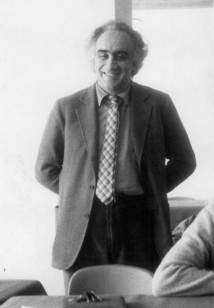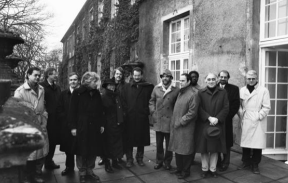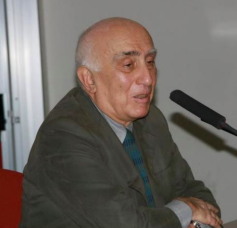Professor Emeritus Luigi Mazza - 1937 – 2023 - An Appreciation

Luigi Mazza, who sadly passed away on the 3rd of May, was a passionate planning scholar, a shrewd and innovative planning practitioner, and an inspiration to generations of students at the Politecnico di Torino (1972-1990) and the Politecnico di Milano (1990-2023). He made a major contribution to building the academic infrastructure for our field and indirectly influenced planning students and scholars around the world, as one of the founders of AESOP and the initiator of the journal which became Planning Theory.
He was one of a generation of planning professors in Europe who created an academically robust intellectual grounding for the planning field, setting its normative and practical dimensions on firmer foundations. And yet, as he states emphatically in his contribution to a series of biographical essays (Mazza 2017), his “personal intellectual journey is that of a self-taught man who trained as a planner through practical experience” (p.72). Educated in architecture, his experience of planning started with the challenge of preparing a local land use plan for his home city of Alessandria. It was this and subsequent practical challenges, which set off his search for intellectual foundations for the analytical understanding and technical requirements needed if a plan or design was to become useful as a practical tool for municipal governments.
Graduating in Architecture from the Politecnico di Torino in 1961, Mazza began working with one of the leading planners of the time in Italy, Giovanni Astengo. He was then drawn into his first major planning task, taking charge of producing the Piano Regolatore and the Piano Provinciale for Alessandria. This task was foundational for how his later thinking developed. He often recalled how he took the task on completely unprepared, and so had to embark on his own self-education. This experience not only fed into his thinking but produced over time a wonderful collection of books, studies and reports, as anyone who visited his home in Milan can attest.
In those early years, Mazza had been inspired by reading Scottish planner Colin Buchanan’s Report Traffic in Towns (published in 1963). This led him to become interested in the British tradition of ‘town and country planning’. His first book, Urbanistica moderna in Gran Bretagna (1976), based on courses given at the Politecnico di Torino, was one result of this interest. He always seemed to know more about Patrick Geddes, Ebenezer Howard and Patrick Abercrombie than any British planner!
From 1962 to 1975 he directed the Documentation Center for Architecture, Civil Engineering and Urban Planning, an institute that collected by subscription the world's leading journals on these disciplines and, through the work of translation and filing by young researchers, disseminated to Italian universities and research institutions the translated synthesis of the best scientific and technical articles from all over the world.
In this openness to the world, Luigi Mazza played a key role in the deprovincialization of Italian planning culture. Some great Italian urban planners of the past, such as Luigi Piccinato or Giovanni Astengo himself, had cultivated international relations but mostly as personal matters. Mazza, on the other hand, posed the problem of pushing the entire national planning community toward an open exchange with the best experiences in the world. In this he encouraged legions of young urbanists to overcome national borders to bring their own culture into a dialogue with an international scientific community that he was helping to build in the meantime.
In the early 1980s, he followed up this work with a tour of British planning schools. One outcome was an invitation to join the editorial board of Town Planning Review, based at Liverpool University. The tour also included the Planning School at Oxford Polytechnic which had organised a series of conferences on ‘planning theory’ in the 1970s and early 1980s. He followed this up with a personal study visit to Oxford which led to the idea which became the 1986 Conference Planning Theory in Practice, jointly organised between Torino and Oxford Polytechnics. It was opened by Giovanni Astengo and closed with a contribution from geographer David Harvey. In retrospect, this was a hugely influential event, as it brought together planning academics from the UK, from Italy, from other parts of Europe, and from North America. It was not just that we all had many extraordinarily rich and challenging discussions. The encounter, so wonderfully orchestrated in the setting of the Castello del Valentino in Torino, also created many academic networks which reverberated through planning academia for the next few decades. This included flowing into the contact list created for AESOP’s first Conference in Amsterdam in 1987. Mazza himself sought to continue planning theory discussions among an international community by instigating the Planning Theory Newsletter in 1988, which eventually morphed into the journal Planning Theory, of which he was the first editor.

He continued to build the academic infrastructure for the planning field when he moved to the Politecnico di Milano in 1990, where he established the doctoral programme in Territorial and Environmental Planning. He also began to emphasise in his teaching the importance of an understanding of the dynamics of real estate development markets, since the ability to shape cities with the public interest in mind depended on being able to influence the location, design and financial choices of market players.
Perhaps the crowning achievement of Mazza’s career was his work on the Documento di Inquadramento for the Comune di Milano. This was a first application of the distinctive approach to plan-making which he had been developing. The Documento was in effect a strategic plan, focused on understanding the dynamics of the city’s development and devising flexible tools to shape it. It was a complete contrast to the spatially-detailed plans which were the norm in Italy. Begun in 1998, it was finalised 2000. It included an essay by Mazza intended to act as a strategic frame of reference when considering individual project proposals. The major proposal was to encourage such projects to cluster along a key transport corridor, and thus relieve pressure on the central core of the city. Rather than fit into a pre-defined zoning plan, to which ‘exceptions’ then had to be negotiated, the Documento started from the assumption that the trajectory of the city’s evolution could not be defined completely in advance, and that what was needed instead were criteria to shape negotiations over major project proposals. These criteria could then be used to evaluate marketinitiated development projects. In this way plans became less important as a specification of what should be built where. Instead, their purpose was to provide a series of arguments underpinning the criteria. A key planning skill then became evaluating project proposals in relation to the criteria. This whole approach was a significant, and controversial, innovation in Italian planning practice. It allowed for flexibility in responding to market initiatives while aiming to secure value for the public realm.
A key preoccupation for Mazza in all his work was the need to make a clear distinction between the technical and political dimension of planning work. He felt that too much emphasis was being given in many academic discussions to the process dimension of planning and too little to the substance. For him, the core substance for the planning field was the dynamics affecting the way land and property were used and developed. He insisted that the only way to consolidate and regenerate the planning field was to focus on understanding these dynamics and the techniques through which they could be shaped to achieve public purposes. His insistence on a clear distinction between technical and political dimensions did not imply any autonomy of the technical work from politics, but it preserved the dignity of technical knowledge to inform those whose duty it was to make decisions in a democratic system of government.
During the 2000s, Mazza published a series of books explaining the thinking underpinning his work on the Documento. These have become a major addition to the Italian planning literature. In recent years, Mazza returned to the history of planning, looking for the roots of planning knowledge, making detailed studies of the writings and urban plans produced by the British planners – Howard, Geddes, Abercrombie and Buchanan- spending two years in Libraries between London and Edinburgh. He then turned to the work of Ildefons Cerdà, a project he was still engaged in when he died. Some of these studies informed his last book, Spazio e Cittadinanza: politica e governo del territorio (2015), published in English as Planning and Citizenship (2016).
Luigi Mazza’s influence was certainly felt and appreciated in North America. As John Forester recalls, Mazza put his vision into practice. He imagined a fully international, scholarly planning theory community, and by inviting us, pushing us, editing us, asking us to respond to one another carefully and respectfully, he led us forward, encouraged us to become more than we had been and to become far more than we were as any sum of dispersed individuals. He made us a whole that was much more than the sum of our parts. This work took a faith in a scholarly community, a faith that we could do this and not be reduced to partisan struggles. So he exemplified qualities of hope and imagination, courage and innovation, willingness to make mistakes and willingness to reach out to attend to new issues, or to see old issues in new ways. He was not shackled by tradition but empowered by it, and he was playful and funny, ironic and imagining better worlds as he did it. Bruce Stiftel echoes Forester’s appreciation as he recalls Mazza’s bravery and tenacity in making the Planning Theory Newsletter happen. It is no wonder that the publisher Sage was later persuaded to take on the project as a refereed journal. Mazza had demonstrated that the intellectual purpose was important, that there were many authors ready to write, and an international audience ready to read. Niraj Verma adds that Mazza’s book, co-edited with Seymour Mandelbaum and Robert Burchell, Explorations in Planning Theory, became an important anthology at a time when there were few such volumes in planning. Besides his many other scholarly contributions, Mazza will be remembered as an institution builder for his pioneering work furthering a trans-Atlantic conversation in planning theory.
Although often sharply critical, one reason for Luigi Mazza’s success in reaching out to other planning academics across countries and continents was that he was such good company. Patsy Healey remembers so many occasions in Oxford, Newcastle, Torino and Milano of vigorous discussion about planning ideas, the differences between being a ‘radical’ person in Italy and Britain, and what was involved in the practice of planning. Sandro Balducci remembers the intense scientific and human exchange that lasted almost 50 years from the time he was 20 years old attending the fascinating course in Urban Planning in Torino: at the final exam Prof. Mazza invited him to work at his Documentation Center, which was Sandro’s first job. Many warm discussions followed over the years between planning and life, up to very recently when he was already very ill but still fatherly, elegant and kind. Many others will have similar memories.
We are all in his debt and will miss such a great colleague and contributor to our field.

[This piece has been created by Alessandro Balducci and Patsy Healey, with inputs from John Forester, Bruce Stiftel and Niraj Verma]
List of key publications
Urbanistica moderna in Gran Bretagna (1976)
Explorations in Planning Theory, edited with Seymour Mandelbaum and Richard W. Burchell, (1996)
Trasformazioni del Piano (1997)
Progettare gli squilibri (2004)
Piano, progetti, strategie (2004)
Prove parziale di Riforma (2004)
Governo del territorio e pianificazione spaziale (with Luca Gaeta and Umberto Janin Rivolin) (2013)
Spazio e Cittadinanza: politica e governo di territorio (2015) ((tr: Planning and Citizenship (2016)
“An Ancient Future” (2017) in ed Beatrix Haselsberger Encounters in Planning Thought: 16 Autobiographical Essays from Key Thinkers in Spatial Planning

